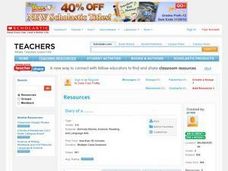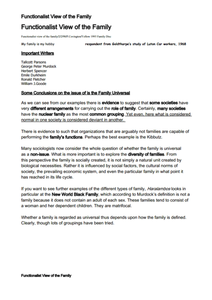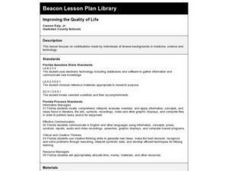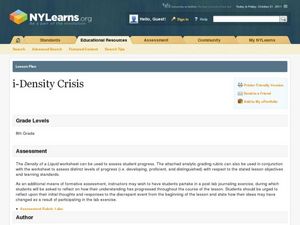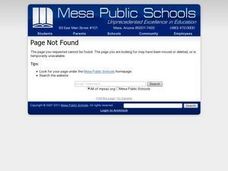Curated OER
Genetics Research Paper & Presentation
Pupils review their information on genetics. Using PowerPoint, they present their findings to the class on the principles of genetic diseases and disorders. They discuss bioethics and identify the positives and negatives of genetic...
Curated OER
Cell Organelles and Their Functions
Young scholars will be using Inspiration, which is a graphic organizer computer program, to create their own model community where they will label the community parts with the corresponding organelle. They will have prior knowledge of...
Curated OER
Chocolate Fever
Students study plants in the rainforest. They complete a variety of activities surrounding the subject of chocolate. They create new candy bars, invent learning games and write poetry--all focusing on chocolate.
Curated OER
Semantic Mapping In Biochemistry
Learners create a semantic map utilizing material learned in previous biochemistry lessons. Their maps will include material on the four types of organic compunds previously explored in class.
Curated OER
Atomic Structure in the Chemistry Classroom
Students are introduced to many of the scientists who contributed to the creation of the model of the atom. The changes to and evolution of the model over time is also covered. At the end of the lesson, Students differentiate between...
Curated OER
Learning from Light: The Big Bang
Students explore what astronomers are able to examine our galaxy and universe by examining light. They explore in this sub-unit the formation of the universe, commonly called "The Big Bang," and it follows studying from the Light: The...
Curated OER
Report on Desert Plant or Animal
Students are introduced to desert plants and animals. They demonstrate that the name of an organism does not always match the object. Students perform a guided internet search in order to complete a report.
Curated OER
Will It Sink Or Float?
Have your class predict whether objects will sink or float in water. Learners consider a data table of mass, volume and whether the object sank or floated. They develop an evidence-based explanation for the results.
Curated OER
Are You Sure You've Got the Right Answer?
Young researchers work through the research cycle. They question, plan, gather, sort, synthesize, and evaluate the materials they collect at the library. There are web supplements for this lesson.
Curated OER
Illinois On Tour
Eighth graders participate in the Illinois Mystery Activity (from the ENTICE materials) to study additional interesting facts about Illinois. Using the DNR poster "Illinois' Natural Divisions" and printed materials from ENTICE, 8th...
American Chemical Society
Colors Collide or Combine?
As part of a unit investigating the dissolving of M&Ms® candy coating, this lesson examines whether or not the different colors combine. There are no new concepts revealed in this particular lesson, but learners will see that the...
Curated OER
Animal Diary
Students create a diary of an animal. In this creative writing lesson plan, students read the book Diary of a Worm and conduct a brief research session on their animal. Students fill in a template with facts and create an animal diary.
Curated OER
Food Chain
Third graders role-play various organisms from a food chain to illustrate how a food chain works. In relay style, 3rd graders fill their cups (stomachs) and, in turn, fill a larger organism's cup (stomach) to visualize the importance of...
Curated OER
Penguin Presentations
Students explore the attributes of penguins. In this penguins lesson plan, students participate in a penguin scavenger hunt and take notes on the information they encounter. Students prepare reports about their findings and share them...
Curated OER
Sunburns and Sore Muscles: Working to Save the Farm During the Great Depression
Fifth through eighth graders engage in a lesson plan in which they study working class people during the Great Depression. They work to develop an understanding of the economic developments in Arkansas during the 1930's. Learners access...
Curated OER
Atomic Structure
Students explore atomic structure. They observe a video on atomic structure and complete a Venn diagram on the parts of the atom. Students create their own graphic organizer on the parts of the atom using Inspiration software.
Curated OER
Pollution Research
Fourth graders explore pollution. They conduct preliminary research on pollution using the internet. Students share their findings with the group. They work with a group and create lists of facts on pollution.
Sociology Central
Functionalist View of the Family
Any social science class studying functionalism and family may benefit from these eight pages of background information and activities. It does not include specific learning objectives, assessments, or rubrics, but it is a great source...
Curated OER
Animal Keynote Report
Learners produce a research project on an animal. Using the Internet, they find pictures and information about animals. They are also given a list of items that should be covered in their report, including the appearance of the animals,...
PBS
Stories of Painkiller Addiction: Learning About Opioids
Feeling high is not the only side effect of abusing prescription opioids. Middle and high schoolers learn more about specific painkillers, including Fentanyl, Oxycodone, and Clonazepam, as well as their common brand names and extensive...
Curated OER
Improving the Quality of Life
Students examine the contributions to medicine, science, and technology by individuals of diverse backgrounds.
Curated OER
i-Density Crisis
Eighth graders determine the density using mass and volume. In this science lesson, 8th graders explain why some materials float or sink. They estimate the density of objects based on whether it floats or sinks in a liquid of known...
Curated OER
Media Campaign
Eleventh graders design and present a media product supporting environmental stewardship. They demonstrate an understanding of the nature and types of waste and of their management in industry and the community. They assess the results...
Curated OER
Organize Ocean Animal Research
Sixth graders research a variety of ocean animals, organizing the facts in the form of a database. They input the results of the research into the appropriate field of their database for their Oceanography Science Unit.













